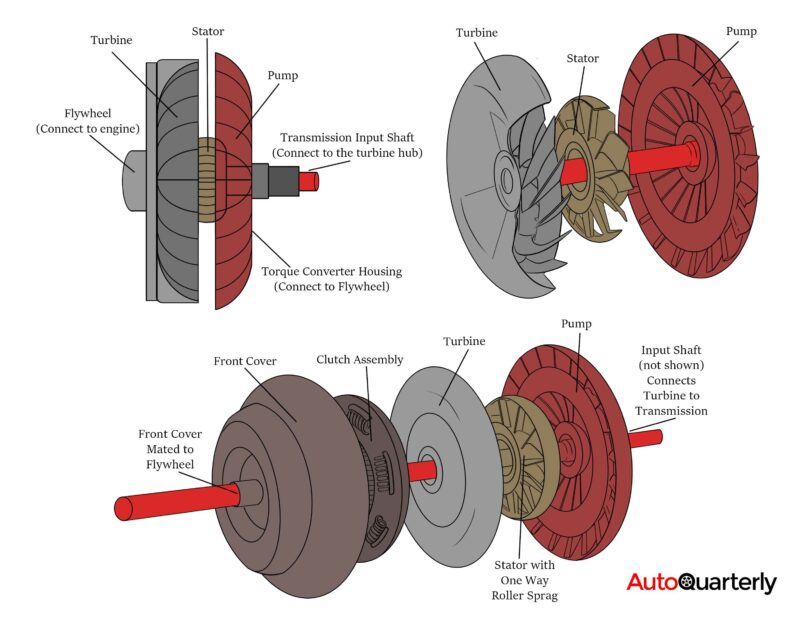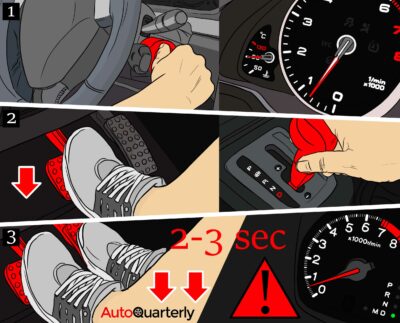The torque converter is responsible for transferring the torque from the engine to the transmission in automatic vehicles. Torque converters are durable components, but they don’t last forever and will wear down over time.
Wear occurs because, when the vehicle is in drive, the torque converter is always spinning. In fact, it spins at the same speed as the engine. If you’re experiencing issues with your torque converter or are unsure about how it works, we’re here to help.
So, what are the reasons to check a torque converter? In short, if your transmission doesn’t feel right and your vehicle is stalling, it’s a sign that your torque converter could be worn out. The good news is that you can check your torque converter at home with a quick stall test.
To do this, press the brake pedal and the gas pedal at the same time for about 3-5 seconds. If the RPMs are lower than your vehicle’s specifications, the torque converter isn’t spinning properly. You can also check for a shudder by lightly tapping the brake pedal when you rev the engine; something is wrong with the converter clutch solenoid or the clutch.
Aside from looking for leaks or bringing your torque converter into the shop, these are some of the best ways to diagnose a bad torque converter. Still, it’s always a good idea to bring your vehicle into the shop if you’re experiencing issues with an important component. For example, you never want to pass the three-click limit when installing the part because you’ll start to scrape metal.
That said, we’re only scratching the surface. Read on to learn everything you need to know below.
What Is a Torque Converter?
Before we dive right into testing out your torque converter, it’s important to understand what this component is. Think about: if you’re not familiar with what the torque converter is, how can you even test it? To go back even further, we’ll start by looking at what torque itself is.
What Is Torque?
The first thing we want to explain is torque, and how it actually works. This will help you get a better understanding of why a torque convertor is needed, and what it’s actually used for.
Think about torque as potential energy. This potential energy is gathered by a twisting motion. A common example of this force can be found in something like a wind-up toy—as you twist its mechanism, the toy stores energy that it will later use to move itself when let go.
The amount of torque that your car has will determine how fast it will accelerate, subject to other factors specific to each vehicle. In cars, torque is generated by turning the car’s crankshaft. This energy is then sent from the torque converter to the transmission of your car.
What Is a Torque Converter?
Now that you’re familiar with what torque actually is, we can start to look at how the torque converter plays a role in the grand scheme of things. Now, with that being said, the torque converter is designed to act as a medium for this potential energy.
All this means is that your torque converter is responsible for transferring torque from the engine to the transmission. It’s actually this transfer of energy that will cause your car to start accelerating.
What Is the Torque Converter Made up Of?
The torque converter sits between the engine and the transmission of your car, where the clutch would be in a manual transmission car, and acts as a buffer between the two.
Here is what this component is made up of:
- A fluid coupling that houses hydraulic fluid.
- The stator, the component that transmits the fluid.
- The impeller, a fan-like system connected to the stator and impeller.
- The turbine, the device that spins the whole unit.
The torque converter almost resembles a series of fans. It uses the impeller, stators, and turbines to move the fluid around within the housing to manage and transfer energy into the rest of the vehicle’s powertrain.
The stator is the primary component for this transfer, so this is where you’ll experience the most wear. Though a fine understanding of the mechanisms of the torque convertor isn’t exactly essential to diagnosing issues with it and resolving them, its operation is best understood visually if you’re interested.
Symptoms of a Worn Out Torque Converter
Now that we’re familiar with the torque converter, it’s important to know what the symptoms of its breakdown are before we dive right into the diagnostic tests. Therefore, in this section, we’ll break down some common symptoms of a worn out torque converter.
A Torque Shudder
If you notice that your engine seems to be a bit shaky, or even a bit scattered, this can be caused by a faulty torque converter. This occurs when the convertor is distributing the energy as equally as it should. If this is the case, you’ll experience this shudder—which can be heard as well as felt.
Poor Acceleration at Low Speeds
If you notice that your car is having problems accelerating at lower speeds, this might be an issue caused by the stator of your torque converter. This symptom will almost appear as a bit of a limp. If your car has a tough time getting moving, this might be a sign that your torque converter needs to be replaced.
A Whirring Sound
Every torque converter will have something called a fluid pump. If this component begins to wear down, or even fail, you’ll definitely be able to hear it. The pump will cause a whirring sound when you start the car, because bubbles may be trapped in the system.
Loud Noises
Cars tend to make a lot of noise, even when they’re running smoothly. While this may be the case, if you hear things like clunking or grinding, it can be a sign of a torque converter issue. These sounds will usually come from the middle of your car, right beneath where you sit. If you’re noticing newer or louder sounds, especially in this area of your car, they might be a sign of a torque converter problem.
Problems Shifting
This can occur at both high and low speeds, and are a serious issue you should never ignore.
What do shifting problems look like?
- Failure to engage a new gear.
- A loud clunking noise when your vehicle slides into gear.
- Trouble getting into first gear when you place the car in drive.
- A lurch when you shift gears.
If you experience any of these symptoms in your vehicle, it might be time to test out your torque converter. Some of these issues can be transmission related, so we always recommend reaching out to a mechanic if you’re unable to fully diagnose them.
How Can I Test the Torque Converter?
Now that we’ve gone over what the torque converter is, and the symptoms of a faulty one, it’s finally time to take a look at how you can test one. We recommend consulting your mechanic if you have transmission issues that you can’t resolve yourself, but this is actually a test that you can do fairly easily. Let’s take a look at the steps for a stall test.
The First Step
The first thing you’ll need to do is turn your engine on. Let the car warm up until you notice that the RPM gauge has leveled out a bit. The exact number will depend on your car, so check your manual, do some online research, or make sure you give it some time to level out if you’re unfamiliar.
The Second Step
Place one foot on the brake pedal, and shift your vehicle into drive. You’ll notice that the RPMs will drop. If your torque converter is in really bad shape, your car may actually end up stalling out if you don’t add any gas. This is a major indication that your torque converter isn’t working.
The Third Step
If your vehicle survived the second step, it’s time to try another diagnostic test. Now, instead of taking your foot off the brakes, push the gas pedal down to the floor for a maximum of three seconds. While you don’t want to exceed 3 seconds, you also don’t want to do this for less than 2 seconds either.
If you notice that your vehicle is cranking out a low RPM rating, this can be a warning sign pointing towards a faulty torque converter. Compare these readings to your vehicles typical RPM can help diagnose a torque converter error. This process is much easier to undertake if you’re following example, so check out this quick video before you head to the garage to try it yourself.
Other Methods for Testing Your Torque Converter
While the stall test is a great indicator, it’s not the only test you can try.
Here are some other quick tests you can try out:
- Go for a long drive and pay attention to the way your car shifts. If it shifts slower than normal, this may indicate a problem with the torque converter
- If you hear clunking or clanging noises when you shift into drive, this might point towards a torque converter issue
- Rev the car up twice (with your foot on the brake), wait for it to idle, and then place the car in drive. If you notice any odd noises, you may have a torque converter issue
These are simple tests that you can try at home, and most of the time they will show you if the torque converter is the problem. While this may be the case, this does not guarantee a solid diagnosis. This is why we always recommend consulting your mechanic if you can’t properly interpret the results.
Final Words
Torque converters aren’t simple, but the basics of their operation are easy enough to grasp. It might seem like a waste of time to test your torque converter, but trust us on this one: it’s very important.
The torque converter is an essential component of an automatic-transmission vehicle, and making sure that it’s operating perfectly is extremely important. Also, knowing what the problem is before taking it to the mechanic can save you quite a bit of money in diagnostics.
If you have any issues, and you can’t seem to pinpoint them, always take your car to a trusted mechanic. When it comes to anything automotive, you want to make sure that you approach repairs and maintenance with great care. This is especially true when working with a component like your transmission, because without proper maintenance it could leave you stranded and subject to expensive repairs.



